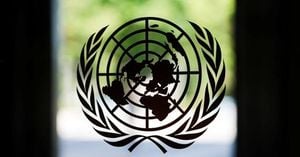On September 20, 2025, Ukrainian President Volodymyr Zelenskyy made a bold announcement: Ukraine will reopen its arms exports, but only under tightly controlled conditions and after ensuring the country’s own defense needs are fully met. This move, revealed in an evening video address and confirmed in meetings with journalists, marks a significant shift in Ukraine’s approach to its burgeoning military-industrial complex after more than three and a half years of relentless conflict with Russia.
Zelenskyy’s message was clear—Ukraine’s first priority remains its own security. “There are clear volumes that our army needs by the end of the year, as well as what is needed for next year and what we should have in our warehouses for defense, to maintain sufficient strength,” he stated, according to reporting by Weapon. Only once those needs are satisfied will Ukraine consider exporting arms to foreign partners. The president emphasized, “Ukraine will not engage in ‘armed charity’ and help those who do not care about Ukraine.”
So, what’s driving this new export push? Quite simply, Ukraine’s domestic weapons production—especially in some categories—has outpaced its own requirements. Zelenskyy highlighted, “Certain types of weapons—these are modern weapons—we can produce in much larger quantities than we can finance ourselves, and certain types of weapons we already have in much larger quantities than we really need in Ukraine today. An example is naval drones, which the world is counting on and which we have in surplus, as well as anti-tank weapons, some other types.”
The president’s remarks, echoed by multiple outlets including DPA and RBC Ukraine, underscore the paradox facing Ukraine’s defense sector: while the front lines and arsenals must remain stocked, the country’s manufacturers are facing idle capacity and a persistent funding gap. According to a survey conducted by the Technological Forces of Ukraine (TSU) association, 38% of defense companies reported that more than half of their capacities are currently idle, and only a third said their workshops are fully loaded. This underutilization is a direct result of the mismatch between what Ukraine can produce and what it can afford to buy for its own forces.
“We are currently at a point where we have weapons, we have capabilities, and we lack funding,” Zelenskyy told journalists, as reported by UNN. “And this is already a permanent feeling that we are constantly in some kind of deficit, but we really don’t want to reduce production capabilities.” Instead, the plan is to sell surplus arms—particularly naval drones and anti-tank weapons—to generate revenue that can be reinvested into producing weapons currently in short supply on the battlefield, like advanced drones for the front.
Ukraine’s arms export strategy will unfold along three main tracks. First, exports and cooperation with the United States will be prioritized, followed by deliveries to European partners, and finally, other countries that have supported Ukraine’s independence and defense efforts. “Within two weeks, a concept will be presented—three new export platforms. The first platform is for exports and interaction with the United States of America, the second platform is our European partners, the third direction is other partners in the world who are also interested in Ukrainian weapons and from whom Ukraine has received one or another support,” Zelenskyy explained.
This approach is not only about market access but also about reciprocity. “It is imperative that they also help us, so that we help them,” the president said. He made it clear that Ukraine will not be exporting arms indiscriminately. “Ukraine will not distribute its weapons as ‘alms’ to those who did not care about Ukraine,” he reiterated, according to Hina. Exports will be subject to “reliable checks” to ensure that “Ukrainian technologies” do not fall into Russian hands or those of their allies.
The export program will include both private and state deliveries, but with strict monitoring of stock balances. The government will control what is shipped abroad, what remains in Ukrainian warehouses, and what needs to be increased. “Exports will be managed, taking into account Ukraine’s production capabilities and the needs of the front,” Zelenskyy stated, as reported by RBC Ukraine.
The timing of this policy is notable. During the full-scale war, Ukrainian weapons production has increased 35-fold, according to Ukrainian Defense Minister Denys Shmyhal. Almost 60% of the Armed Forces’ supplies are now Ukrainian-made, a dramatic turnaround from the early days of the Russian invasion when the country relied almost entirely on Western military aid. Ukrainian developers have even produced unique Magura naval drones, which have been used to destroy Russian fleet assets and other enemy targets at sea.
Ukraine’s drone industry, in particular, stands out. On July 3, 2025, Ukraine and the American company Swift Beat signed a memorandum on expanding drone production, ensuring the Armed Forces receive drones needed to intercept missiles. The Ukrainian company Frontline also inked a strategic agreement with the German-Ukrainian drone manufacturer Quantum Systems, further boosting local capacity and technological prowess.
However, the path to becoming an arms exporter is not without obstacles. Industry voices have raised concerns about the lack of legislative regulation on arms exports. Andriy Rymaruk, Deputy General Director of Ukrspecsystems, lamented, “Excellent theses were born, a new law on Defence City began to be created. The law was adopted, but what we were working on is not in it.” The president of the Technological Forces of Ukraine association, Vadym Yunyk, has also called for more robust and controlled frameworks for arms exports.
Some in the Ukrainian military-tech sector are wary of inflated expectations. A co-founder of Tencore described the opening of arms exports as “a cold shower for many,” suggesting that not all companies will benefit equally or immediately. The sector’s optimism is tempered by the reality of global competition and the need for rigorous export controls.
Meanwhile, at the Defense Tech Valley investment summit in Lviv, a new model of the TOLOKA underwater drone was presented, highlighting the ongoing innovation within Ukraine’s defense industry. These developments underscore the country’s ambition to not only meet its own security needs but to become a significant player in the global arms market.
As Ukraine prepares to unveil its detailed export concept in the coming days, all eyes will be on how the country balances its urgent defense requirements with the economic and strategic opportunities of arms exports. The stakes are high, but so too is the potential for Ukraine to transform its wartime ingenuity into a sustainable, world-class defense industry—one that supports its sovereignty while contributing to global security.





